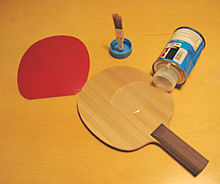A table tennis blade is the mainly wooden middle part of a table tennis racket. Due to the variety of blades and rubbers in table tennis, players usually buy the blade and the rubber separately.[1] A blade's weight, size, shape, material, and handle all, in different ways, affect how the racket interacts and returns the ball.[2]

Material
editAccording to the International Table Tennis Federation (ITTF) regulations, 85% of the blade must be composed of wood, but other materials like graphite are allowed.[1] Blades with no graphite are called wooden blades, while paddles with graphite/carbon are called carbon blades. Wooden blades can come in one-ply to nine-ply wood; the amount of plies, distribution, thickness, and density of the wood all affect the speed and spin of the paddle to varying degrees.[2] Carbon blades tend to have more speed and less spin, and are more expensive than wooden blades.[2]
Size and shape
editOffensive close-to-the-table players usually prefer smaller blades because there is less air resistance on the paddle, facilitating swing speed. Defensive players prefer larger paddles because there is a larger surface area for hits.[2][1]
Weight
editThe weight of the blade is affected by the material's composition and density and the blade's size and shape. The overall racket's weight is also influenced by the weight of the rubber and how much glue is added.[2] As a rule of thumb, the lighter a blade is, the easier it is to control, and the heavier a blade is, the more spin can be applied.[2]
Handle
editThere are four popular handle designs: the straight, conic, flared, and anatomic.[2] Usually handles are selected based on personal preference, though it also depends on which paddle grip the player prefers, and if the player flips paddle sides often during play.[1]